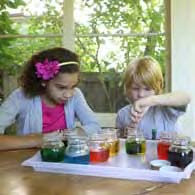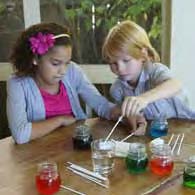
I think getting outdoors and being with nature are very important for kids and even adults in the days of the technology-laden society. The Outdoor Science Lab for Kids gives you 52 family-friendly at home science experiments with most materials you can probably conjure up from the garage or home.
The Outdoor Science Lab for Kids includes 200 color photos and is geared for kids 7-10 years of age. My oldest child at nine has been anticipating our time together to try out more of the provided projects from this book. My youngest two loved creating the Produce-Bag Parachutes. They have been launching Lego men with parachutes from our main floor to the basement for several days now.
Check out what other bloggers are saying about this title and Kitchen Science Lab for Kids also by Liz Lee Heinecke. They also have other science experiments to try and some are offering a giveaway!
April Noelle http://www.aprilnoelle.com
Happy Healthy Hip Parenting http://www.happyhealthyhip.com/blog/
Mom of 2 Dancers http://www.scrappyd.blogspot.com
Just Joanna http://justjoanna.com
Familylicious http://familylicious.com/
Say it, “Rah-shay” http://sayitrahshay.com/
Honey Badger Mom http://honeybadgermom.com
The Life of a Home Mom http://homemom3.com
Mom, Are We There Yet? http://momarewethereyet.net
Bless Their Hearts Mom http://blesstheirheartsmom.blogspot.com
Cassandra M’s Place www.cassandramsplace.com
My Silly Little Gang![]() http://mysillylittlegang.com
http://mysillylittlegang.com
Houseful of Nicholes http://housefulofnicholes.com
Cook with 5 kids http://cookwith5kids.blogspot.com
About the Author:
Another fun book by Liz Lee Heineke is Kitchen Science Lab for Kids.

Here is a sampling from The Kitchen Science Lab for Kids below to create your own rock candy. This project is perfect for Halloween!

ROCK CANDY
Grow colorful, delicious sugar crystals on a stick.
Materials
- 5 cups (1 kg) white granulated sugar (plus more for step 1)
- 2 cups (470 ml) water
- Cake-pop sticks or wooden skewers
- Medium-size pot, to boil the water
- Glass containers
- Food coloring
Protocol
- Step 1: Dip one end of the cake-pop sticks or wooden skewers in water and then roll them in the sugar. The sugar should cover 2 to 3 inches (5 to 7.5 cm) of the sticks. Let them dry completely. These are the seeds for the sugar crystal growth.

- Step 2: Boil the 2 cups of water and the 5 cups sugar in a medium-size pot until the sugar is dissolved as much as possible. It should look like syrup. Once cool, this is your supersaturated sugar solution.
- Step 3: Let the syrup sit until it is no longer hot, and pour into glass containers. Add food coloring and stir.

- Step 4: When the colored syrup has cooled to room temperature, set the sugary end of the sugar-seeded cake-pop sticks or skewers into the syrup and let them sit for about a week. Gently move the sticks around occasionally, so they don’t stick to the crystals in the bottom of the glass. If the glass container gets too full of crystals, pour the syrup into a new container and move your stick into the clear syrup to grow more crystals.
- Step 5: When the rock candy is done, drain the excess syrup and let the sticks dry. Look at them under a magnifying glass for a close-up look.

- Step 6: Bon appétit!
Creative Enrichment
- What other surfaces could you grow sugar crystals on? How big will they get? If you leave your rock candy in sugar solution for months, will the crystals continue to grow?
Safety Tips and Hints
- This experiment requires adult supervision for boiling and handling the hot sugar syrup. Once it’s cooled down, the kids can take over.
The Science Behind the Fun
- Like bricks in a wall, crystals are solids formed by a network of repeating patterns of molecules. Instead of the mortar that holds brick together, the atoms and molecules are connected by atomic bonds.
- Crystals that share the same chemical composition can be big or small, but the molecules always come together to form the same shape. Table sugar, or sucrose, is made up of a molecule comprised of two sugars, glucose and fructose. Crystals formed by sucrose are hexagonal (six-sided) prisms, slanted at the ends.
- The crystals that make up your rock candy grow larger when the sugar molecules in the syrup bind to the seed crystals of sugar that you rolled onto the stick.
From Kitchen Science Lab for Kids by Liz Lee Heinecke
© 2014 by Quarry Books
Text © 2014 Liz Lee Heinecke
Photography © 2014 Amber Procaccini Photography
[gview file=”https://centralmnmom.com/wp-content/uploads/2016/10/Rock-Candy-Experiment-pdf-1.pdf”]
Giveaway:
One reader will win a copy of Outdoor Science Lab for Kids. Please use the Rafflecopter form below to record your entries. This giveaway is open to residents of the USA 18+.
a Rafflecopter giveaway
Disclosure: I received a copy of The Outdoor Science Lab for Kids to review. No other compensation was received for this post.

